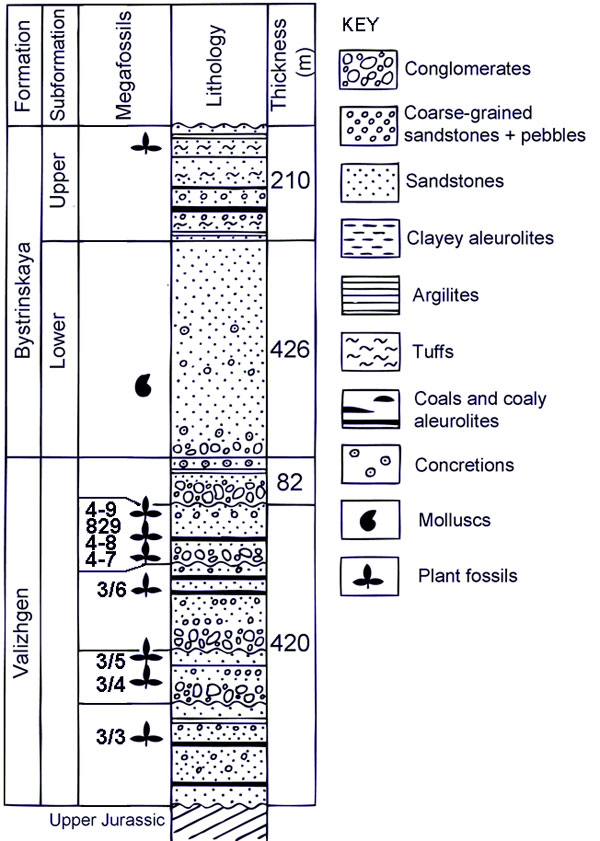Cape Konglomeratovyi
| Cape Konglomeratoviy | Cape Valizhgen | Yelistratov Peninsula | Penzhina Floral Phase | Kaivayam Floral Phase | NE Russia Map |
|---|---|---|---|---|---|
| Northwest Kamchatka Geology | Fossil Images | ||||
IntroductionNear Konglomeratoviy Cape plant fossils have been collected in a continuous section of the Valizhgen Formation from several plant-bearing beds mostly represented by coarse-grained sandstones, sand-clayey and coal-clayey shales. Two taphofloras are distinguished here, i.e. Penzhina and Kaivayam (Herman, 1991, 2011). The Penzhina TaphofloraThe Penzhina Taphoflora comes from the lower part (localities 3/3, 3/4 and 3/5) of the Valizhgen Formation on the Konglomeratoviy Cape (see right). This taphoflora is characterized by abundant platanoid leaves (six species) assigned to the genera Ettingshausenia, Arthollia, Paraprotophyllum. Especially prominant are Arthollia pacifica, Paraprotophyllum ignatianum and Ettingshausenia newberryana which are represented by a great number of specimens. Three species of Celastrophyllum have been encountered, specimens of C. retinerve (formally known as Compositiphyllum retinerve (Herman) Herman et Kvacek: Herman and Kvacek, 2010) being the most numerous. The taphoflora is also characterized by significant occurences of Cephalotaxopis, Sequoia tenuifolia, Menispermites, Trochodendroides, Myrtophyllum. Gleichenia, Cladophlebis, Ginkgo, Protophyllocladus, "Zizyphus", Viburniphyllum, Penzhinia, Dalembia have also been reported but are rarer. The Kaivayam TaphofloraThe Kaivayam Taphoflora comes from the middle and upper beds of the Valizhgen Formation on the Konglomeratoviy Cape. The taphoflora has an abundance of platanoids Paraprotophyllum pseudopeltatum and Arthollia insignis as well as "Zizyphus" smilacifolia, Viburniphyllum lebedevii and representatives of the genera Magnoliaephyllum and Araliaephyllum. There are also frequent occurrences of Ruffordia, Birisia (?) oerstedtii, Ginkgo ex gr. adiantoides, Cephalotaxopsis heterophylla, Sequoia tenuifolia, Paraprotophyllum ignatianum, Arthollia pacifica, Dalembia pergamentii, etc. Representatives of the genera Magnoliaephyllum and Araliaephyllum, as well as some species of other genera (including comparatively rare Trochodendroides sachalinensis and Quereuxia angulata), are known from the Kaivayam taphoflora but have not been reported from the Penzhina taphoflora. Apart from this, the Kaivayam taphoflora differs from the Penzhina in lacking the genera Gleichenia, Celastrophyllum, Grebenkia, Penzhinia and the species Menispermites septentrionalis, Ettingshausenia primaeva, Arthollia inordinata, Paraprotophyllum cordatum, etc. Additionally fewer Ettingshausenia newberryana, Paraprotophyllum ignatianum and Arthollia pacifica that dominate the Penzhina taphoflora occur in the Kaivayam. Thus, both the generic/specific composition and the main dominants make the two taphofloras considerably different. Two subcomplexes can be distinguished within the Kaivayam taphoflora. The Early Kaivayam subcomplex extended through the middle part of the Valizhgen formation on the Konglomeratoviy Cape. The large-leaved platanoid plants are present in significant, although somewhat lesser, quantities than in the Penzhina taphoflora, being represented by the genera Ettingshausenia (one species), Arthollia (two species) and Paraprotophyllum (two species). Also frequently occurring are Cephalotaxopsis heterophylla, Sequoia tenuifolia as well as the representatives of the genera "Zizyphus", Myrtophyllum, Viburniphyllum, Trochodendroides, entire-margined Magnoliaephyllum alternans. The finding of the unusual leaf types named Ternstroemites harwoodensis, Araliaephyllum quinquelobum and Cissites inscissus (Herman, 1991) are particularly interesting. |
Map of the Cape Konglomeratovyi area showing the distribution of Cretaceous rocks.
Lithology and stratigraphy of rocks in the vicinity of Cape Konglomeratovyi, Northwestern Kamchatka. |
|
The Late Kaivayam subcomplex comes from the upper part of the Valizhgen Formation at Cape Konglomeratoviy. Platanoid plants are quite common including Paraprotophyllum (two species, of which P. Pseudopeltatum is particularly numerous) and Arthollia insignis. The genus Magnoliaephyllum is represented by another species and lesser number of specimens than in the Early Kayvayam subcomplex. Ginkgo, Cephalotaxopsis, Sequoia, Araliaephyllum, "Zizyphus", Viburniphyllum, Trochodendroides, Dalembia (two species), Dicotylophyllum dombeyopsoidum have been often found. This subcomplex, unlike the Early Kaivayam, has exhibited numerous unique species (Magnoliaephyllum magnificum, Ettingshausenia prisca, Araliaephyllum leonovii, Viburniphyllum lebedevii, Dalembia krassilovii, Dicotylophyllum longipetiolatum, etc). On the other hand, Menispermites, Ternstroemites, Ettingshausenia newberryana, Arthollia pacifica have not been recorded. Thus, the differences between the subcomplexes mainly relate to the occurrence of certain angiosperm species, absence of other plants, a somewhat greater role of Magnoliaephyllum and the lower abundance of platanoids in the Early Kaivayam subcomplex (Herman, 1991). There are two competing views on the correlation of the Valizhgen Formation and marine deposits situated south of the Konglomeratoviy Cape. According to one of these the age of flora-bearing beds is assessed as Turonian (excluding lowermost Turonian) - Coniacian. The second estimate is the Late Albian - Coniacian. Paleobotanical judgement of the age of the Penzhina taphoflora may help solve this contradiction. The composition of the Penzhina taphoflora does not allow it to be older than the Turonian. This is determined by the predominance of platanoid plants with large leaves (three genera with six species) which first appeared in significant quantities in Northeastern Asia in the latest Albian - Cenomanian - (?) earliest Turonian Grebenka flora (but are represented only by one species of Ettingshausenia), but are more numerous and diverse in the Early Coniacian Poperechninskaya taphoflora from the Pekulney Ridge (Terekhova and Filippova, 1983), Turonian Volchinskaya taphoflora from the Anadyr River basin (Devyatilova et al., 1980), and Coniacian Ainussian flora of Sakhalin (Krassilov, 1979). These three floras are well-dated by ammonite and inoceramid fossils. Other evidence includes the presence in the Penzhina taphoflora of a number of fossil plants typical for the Turonian and Senonian floras of Northern and Northeastern Asia, i.e., Thus, the paleobotanical data support Pergament's (1961) point of view and permit us to exclude the Mameta Formation as one of the likely marine equivalents of the Valizhgen Formation. This, in its turn, provides more grounds to date the lower strata of the Valizhgen Formation (and the Penzhina taphoflora) as Turonian, possibly excluding lowermost Turonian. The Kaivayam taphoflora comes from the beds overlying the plant-bearing deposits of the Penzhina taphoflora in one and the same uninterrupted section. The middle and upper parts of the Valizhgen Formation containing the Kaivayam taphoflora can, in all likelihood, be correlated with deposits of marine origin belonging to the Pell-El Formation and containing the Coniacian mollusc remains. The plant-bearing beds of the Kaivayam taphoflora are overlain by the Santonian deposits of the Bystrinskaya Formation with marine mollusc fossils. Thus, the age of the Kaivayam taphoflora is assessed as Coniacian (Herman, 1991). |
||


